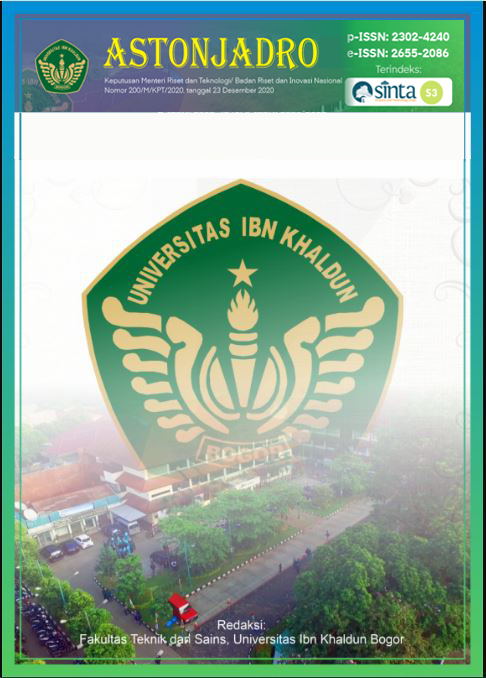Effect of Compaction Temperature Variations on the Characteristics of Marshall Asphalt Concrete-Wearing Course [AC-WC] using Modified Asphalt (Asphalt Pertamina PEN 60/70 with Addition of 1.5% Styrofoam)
DOI:
https://doi.org/10.32832/astonjadro.v12i1.8277Keywords:
modified asphalt 1.5% styrofoam, compaction temperature, marshall test, BTDC.Abstract
The road is one of the transportation infrastructures which is a basic need in community activities. Along with the development of road construction, road construction materials are needed that are more environmentally friendly and can improve the quality of the asphalt mixture. Styrofoam is one of the materials that can be added because styrofoam is a thermoplastic material. The compaction temperature is also a factor that it must consider during the implementation in the field because it will determine the level of asphalt stability. This research was conducted by an experimental method using modified asphalt with a mixture of 1.5% styrofoam. The optimum asphalt content used is 6%, with compaction temperatures of 80°C, 90°C, 100°C, 110°C, and 120°C based on the plot of the Bitumen Test Data Chart (BTDC). The data analysis is based on the results of the Marshall parameter values. The test uses asphalt inspection test equipment and Marshall test equipment. The results of this study are that the lower the compaction temperature, the smaller the Marshall parameter value, and the higher the compaction temperature, the higher the Marshall parameter value. Asphalt parameters decreased. Based on the Marshall test carried out, the compaction temperature that meets the requirements of the 2018 Highways specification from a temperature range of 80°C to 120°C with an interval of 10 C is at a temperature of 110ËšC and 120ËšC.
References
Azhari, W., Palangka Raya Jl Yos Sudarso, U., & Raya, P. (2018). PENGARUH VARIASI SUHU PEMADATAN TERHADAP CAMPURAN HOT ROLLED SHEET-BASE (HRS-BASE). Prosiding Forum Studi Transportasi Antar Perguruan Tinggi, 4–5. https://ojs.fstpt.info/index.php/ProsFSTPT/article/view/353
Liu, B., Li, J., Han, M., Zhang, Z., & Jiang, X. (2020). Properties of polystyrene grafted activated waste rubber powder (PS-ARP) composite SBS modified asphalt. Construction and Building Materials, 238, 117737. https://doi.org/10.1016/J.CONBUILDMAT.2019.117737
Lolok, N., Ali, N., & Rachman ', R. (2021). Pengaruh Styrofoam Sebagai Bahan Tambah Pada Campuran Laston Lapis Aus. Paulus Civil Engineering Journal, 3(3), 397–405. https://doi.org/10.52722/PCEJ.V3I3.291
Made, D., & Ningsih, R. (2022). KAJIAN PERLINDUNGAN HUKUM TERHADAP PENYEDIA JASA TRANSPORTASI ONLINE DALAM PELAYANAN JASA DALAM PENGANGKUTAN PENUMPANG. Jurnal Ilmiah Raad Kertha, 5(1), 34–41. https://doi.org/10.47532/JIRK.V5I1.420
MADE DWI ARI PRABAWA, I. (2021). PENGARUH PENAMBAHAN MINYAK JELANTAH PADA ASPAL MODIFIKASI STYROFOAM TERHADAP KINERJA LASTON LAPIS AUS.
Mamangkey, R., Kaseke, O. H., Jansen, F., & Manoppo, M. R. E. (2013). KAJIAN LABORATORIUM SIFAT FISIK AGREGAT YANG MEMPENGARUHI NILAI VMA PADA CAMPURAN BERASPAL PANAS HRS-WC. JURNAL SIPIL STATIK, 1(3), 196–201. https://ejournal.unsrat.ac.id/index.php/jss/article/view/944
Martanto Adji, B., Teknik Sipil, J., & Andalas, U. (2020). STUDI PENGGUNAAN LIMBAH STYROFOAM PADA PERKERASAN ASPAL PORUS. Ruang Teknik Journal, 3(2), 167–172. https://doi.org/10.31869/RTJ.V3I2.1705
Mawardi, A., Machsus, M., & ... M. K. (2020). Efek Variasi Suhu Pemadatan Campuran Laston Lapis Pondasi (AC-Base) dengan Penambahan Limbah Plastik. Iptek.Its.Ac.Id. http://iptek.its.ac.id/index.php/jats/article/view/6423
Melyna, E. (2021). Hidrokarbon Hasil Perengkahan Sampah Polystyrene Foam. QUIMICA: Jurnal Kimia Sains Dan Terapan, 3(1), 1–5. https://doi.org/10.33059/JQ.V3I1.3383
Muchtar, F., & Ramli, M. I. (2018). ESTIMASI SEBARAN EMISI LALU LINTAS BERBASIS MODEL CALINE-4 PADA LINGKUNGAN JALAN TIPE 8/2D DI MAKASSAR. Prosiding Forum Studi Transportasi Antar Perguruan Tinggi, 4–5. https://ojs.fstpt.info/index.php/ProsFSTPT/article/view/258
Musa, M. I., Akhmadali, -, & Widodo, S. (2019). ANALISIS JENIS PELARUT UNTUK EKSTRAKSI ASPAL PADA PERKERASAN AC-WC (ASPHALT CONCRETE – WEARING COURSE). JeLAST"¯: Jurnal PWK, Laut, Sipil, Tambang, 6(3). https://doi.org/10.26418/JELAST.V6I3.36601
Muyassar, A. R., & Syarwan, E. M. (2021). SUBTITUSI TEMPURUNG KELAPA SEBAGAI AGREGAT HALUS TERHADAP CAMPURAN LASTON AC-BC. Jurnal Sipil Sains Terapan, 4(01). http://e-jurnal.pnl.ac.id/JSST/article/view/2377
Pramiyati, T., Jayanta, J., & Yulnelly, Y. (2017). PERAN DATA PRIMER PADA PEMBENTUKAN SKEMA KONSEPTUAL YANG FAKTUAL (STUDI KASUS: SKEMA KONSEPTUAL BASISDATA SIMBUMIL). Simetris: Jurnal Teknik Mesin, Elektro Dan Ilmu Komputer, 8(2), 679–686. https://doi.org/10.24176/SIMET.V8I2.1574
Rachman, F., Hidayat, R., & Nazar, N. (2019). Tinjauan Perencanaan Tebal Perkerasan Jalan Lambaro – Bts. Pidie Dengan Metode Manual Desain Perkerasan Jalan Tahun 2017. Tameh: Journal of Civil Engineering , 8(2), 100–110. https://doi.org/10.37598/TAMEH.V8I2.92
Waani, J. E. (2013). Evaluasi Volumetrik Marshall Campuran AC-BC (Studi Kasus Material Agregat di Manado dan Minahasa). 20(1).
Weimintoro, A., Ahmad, R. K., Farid, A., & Salsabila, N. S. (2022). Pengaruh Penambahan Limbah Karet Ban Sebagai Substitusi Sebagian Kadar Aspal Terhadap Stabilitas AC-BC Dengan Metode Marshall Test. Rekayasa: Jurnal Teknik Sipil, 7(1), 25–30. https://doi.org/10.53712/RJRS.V7I1.1558
Downloads
Published
How to Cite
Issue
Section
License
Copyright (c) 2022 ASTONJADRO

This work is licensed under a Creative Commons Attribution-ShareAlike 4.0 International License.
Paper submitted to ASTONJADRO is the sole property of the Astonjadro Journal. Unless the author withdraws the paper because he does not want to be published in this journal. The publication rights are in the journal Astonjadro.ASTONJADRO
LICENSE
This work is licensed under a Creative Commons Attribution-ShareAlike 4.0 International License.
Based on a work at http://ejournal.uika-bogor.ac.id/index.php/ASTONJADRO













